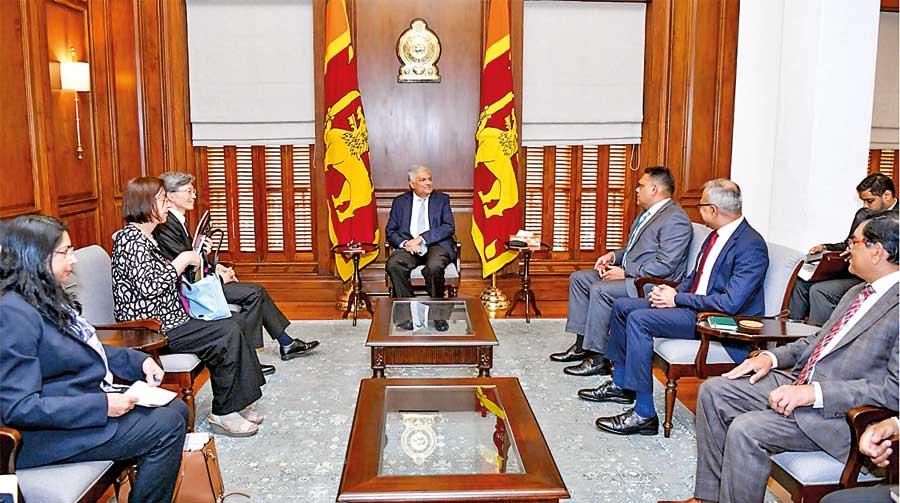01 Jul 2024 - {{hitsCtrl.values.hits}}

Sri Lanka has approached the IMF on 17 occasions to seek assistance from the global lender
During my formative years, when I took up long distance running, I became fascinated with the seemingly effortless rhythm of the Kenyan runners that I watched on TV. Never to achieve my dream of running like those agile Kenyan women and men, in my later years I read of the anti-colonial Mau Mau rebellion in the 1950s and the brutal British counter-insurgency that presaged the independence of Kenya. Those earlier images in my mind were brought alive by the formidable protests against rising taxes and crippling austerity in Kenya last week.
rhythm of the Kenyan runners that I watched on TV. Never to achieve my dream of running like those agile Kenyan women and men, in my later years I read of the anti-colonial Mau Mau rebellion in the 1950s and the brutal British counter-insurgency that presaged the independence of Kenya. Those earlier images in my mind were brought alive by the formidable protests against rising taxes and crippling austerity in Kenya last week.
The valiant push of the Kenyan youth at the barricades last week, cannot but remind us of our youth storming the presidential palace in Colombo exactly two years ago. The demands of the Kenyan movement now for the resignation of their president echoes what we heard here all over Sri Lanka, resulting then in the flight of President Gotabaya Rajapaksa.
In this context, there are many poignant lessons from the crisis and protests in Kenya, for Sri Lanka and for the global South more broadly. The ruling elite in much of the global South have little vision beyond the tutelage of the West and the IMF. The current international financial system is the cause for rather than a solution to the repeated and deepening debt crises. Furthermore, it is futile to pursue the IMF’s path of debt resolution, as the IMF’s interests are aligned with those of the creditors and the West, which reinforce an unequal and extractive global order.
Washington and Nairobi
Kenya has been in the middle of an extensive IMF program over the last few years, and has been pitched as a success story avoiding default. And just one month ago, Kenyan President William Ruto was welcomed at the White House, to launch “The Nairobi–Washington Vision”
Amidst much fanfare, the vision document claims: “High-ambition countries receive high-ambition financial support … by high ambition from international financial institutions, including the IMF and World Bank, and from official bilateral creditors.”
With all this patronising “high ambition” talk from the White House, the last lines of the vision give it away as more old wine in new bottles: “Private sector-focused MDBs (Multilateral Development Banks) and bilateral official creditors, including through DFIs (Development Finance Institutions), enhance support for private investments in sustainable finance by scaling up vehicles that help mobilise private capital and deepen local capital markets.” In other words, the solution for Washington is as usual more financialisation led by global financiers prying open the global South by linking up with local financiers. That such financialisation is at the root of the current wave of sovereign debt crisis propelled by commercial borrowing in international capital markets is not a consideration. After all, this is the route for further extraction for the global financiers in Wall Street, who in fact control the White House.
Just one month after all this high ambition talk in Washington, protests erupted in Nairobi against the austerity measures and the moves to raise further taxes. Those tax hikes themselves were pushed by the IMF in Washington. The IMF statement on 11 June 2024, when it reached Staff Level agreements on three of its loan facilities with Kenya, had the following to say:
If the Opposition in Colombo cannot come up with an alternative to the IMF path of so-called economic recovery, their political future may end up the same as in Kenya
“A sizable and upfront fiscal adjustment in FY2024/25 will be needed to correct the course. To this end, the authorities have taken decisive steps towards fiscal consolidation by introducing several measures in the context of the draft 2024/25 Budget and the 2024 Finance Bill. Importantly, the latter centers on measures to broaden the domestic tax base… public expenditure and wage bill reforms, state-owned enterprise restructuring, rationalising unproductive current spending, and better targeting of subsidies and transfers…”
It is this Finance Bill and the moves to increase taxes including on essentials even as austerity measures continue to claw into public investment, state supports, wages and state enterprises, that led to such public outrage. Protest slogans included, “Kenya is not IMF’s lab rat.” This IMF story is all too common, with high ambition promises in Washington and the reality of social suffering in the global South. Indeed, unless there is South-South solidarity to form a “Debtors Coalition” and to chart a different path of development, we will continue to be treated like lab rats by the IMF and the West.
Colombo and elections
The shell around the IMF’s claims of resolving debt crises has started to crack. Even as the rebellion in Nairobi was unfolding with damning criticism of the IMF last week, our President wanted to celebrate the IMF arbitrated debt restructuring deal with Sri Lanka’s bilateral creditors. While the bondholders who hold an even larger share of debt are yet to agree, the terms of the deal just kicks the can down the road, and provides a haircut of a mere 30%. Sri Lanka from 2027 onwards, will be paying the equivalent of 4.5% of GDP in external debt servicing every year. Such external debt payments will amount to 30% of government revenue each year, given an IMF target for government revenue of 15% of GDP. The working people in Sri Lanka are already unable to bear the recent hikes in the indirect and regressive Value-Added Tax (VAT). Furthermore, to meet the IMF target, government revenues have to be increased from 11% of GDP last year to 15% of GDP by 2026. Yet paying this entire increase in additional revenues for external debt servicing is claimed as a good deal out of bankruptcy for Sri Lanka; a political move rushed ahead of the upcoming elections. But in fact, it has made the country more susceptible to another default in a few years, and repeated cycles of austerity and dispossession.
The arrogance of the comprador elite in Colombo, could not have been better captured than by the statement of President Wickremesinghe last week:
“Recent riots in Kenya, where around 20 people have been shot dead, highlight the consequences of economic instability. If we do not establish economic stability in Sri Lanka, we could face similar unrest. Therefore, funds should be allocated to these countries, and Sri Lanka fully supports this initiative. However, Sri Lanka does not seek such aid for itself; we are managing our debt independently, utilising our energy and knowledge. We must continue this path, transforming into a competitive, digital, and green economy.”
It is as if the President with his high ambition wants to go to the White House and unveil a Colombo–Washington Vision!
The political opposition in Colombo waiting for the elections later this year need to wake up. If they cannot come up with an alternative to the IMF path of so-called economic recovery, their political future may end up the same as in Kenya. President Ruto won an election in Kenya in the middle of an IMF program, but within two years he is facing calls for resignation. Even as we express our solidarity with the courageous protestors in Kenya, we must also learn from their experience. To have a new government with its head in the right place, the mobilisations and struggles in the lead up to the elections may become as important as the elections themselves.
24 Nov 2024 2 hours ago
24 Nov 2024 4 hours ago
24 Nov 2024 5 hours ago
24 Nov 2024 6 hours ago